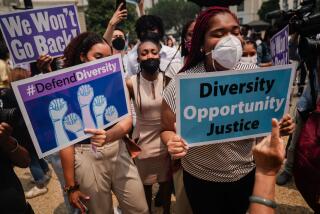Sidetracked Civil Rights
- Share via
Congress went home for the holidays without having passed a single piece of civil-rights legislation in 1985. Yet a critically important bill awaits action. It restates a policy that should be obvious: No federal money should support institutions that discriminate on the grounds of race, sex, age or physical handicap.
For 20 years that had been a clearly articulated national policy, starting with the passage of the Civil Rights Act of 1964. That policy was seriously eroded in a 1984 U.S. Supreme Court decision involving Grove City College in Pennsylvania. The court held that while federal aid to students was indeed aid to the college, it triggered restrictions against discrimination only in the program directly involved. The student-aid office thus was covered, but not the rest of the school.
Many members of Congress said that this was too narrow an interpretation. Still, the Justice Department indicated that the decision, which involved sex discrimination, would be applied to similarly worded statutes barring federal subsidies to institutions that discriminate against minorities, the elderly or the handicapped.
Since the Grove City decision, the Department of Education has indeed dropped several key cases. One involved charges that the University of Maryland’s intercollegiate athletic program did not provide the same travel allowances and support services to female athletes that it did to males. Such sex discrimination had clearly been prohibited under Title IX of the Education Amendments of 1972, which helped expand opportunities for women and girls in sports. The number of high school girls in sports has increased from 7% to 35%, and the number on college athletic scholarships has grown from virtually none when Title IX was passed to more than 10,000 today. Many more women now attend medical, law, veterinary and graduate schools as well, thanks to federal efforts to end sex discrimination.
To overturn the Supreme Court ruling and correct any misapprehension that the Justice Department has about legislative intent, Congress has been considering the Civil Rights Restoration Act of 1985. The bill would make it clear that if an institution received federal money for any program or activity, the entire institution would be covered by anti-discrimination laws. The measure has wide bipartisan support, which is appropriate because three of the four laws involved were signed by Republican Presidents. Fourteen high officials from the Johnson, Nixon, Ford and Carter Administrations have testified in favor of the legislation, saying that they never had any problem with what Congress meant.
What should be obvious is not, however. Some House members seek to entangle the measure in the abortion debate, where it does not belong. Others want to exempt institutions with religious affiliations. Institutions controlled by religious groups are already legitimately exempt; this amendment would broaden the loophole through which 800 to 900 institutions might escape coverage.
The bill has never come to the House floor, because the civil-rights forces lack the votes to beat back amendments that have little to do with the substance of the measure. When Congress returns to work, it should resolve to clarify the law and put civil-rights policy back on a track that it should never have left.
More to Read
Sign up for Essential California
The most important California stories and recommendations in your inbox every morning.
You may occasionally receive promotional content from the Los Angeles Times.










